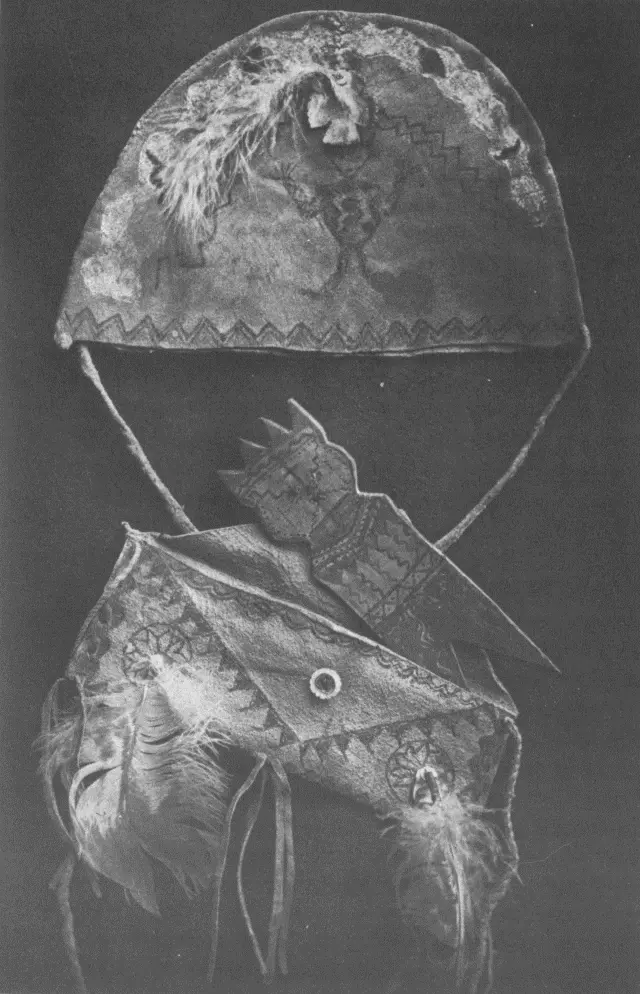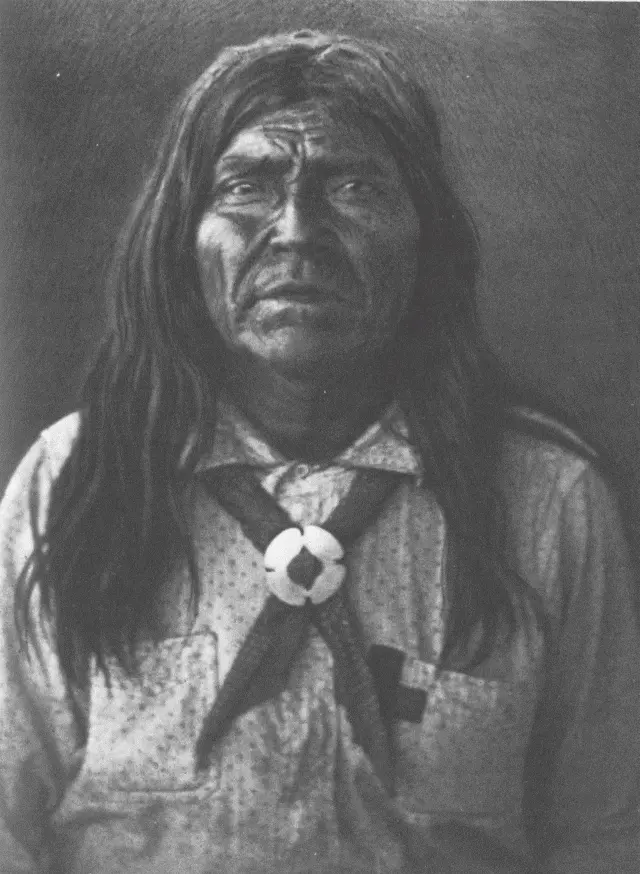The belt is made from skin of the mountain lion, the black-tail deer, the white-tail deer, and the antelope—animals which give birth to their young without trouble. Medicine-men are called in to pray to the spirits of these animals when a woman approaching confinement puts on the belt. It is worn for a day or so only, but constantly during the critical period, not being removed until after the child is born. Prayers are made, first by a mother or father for their daughter, then by a medicine-man, and lastly by the patient to the gods and elements depicted on the belt. These figures are all connected with lightning lines. The first one to the left is Stĕnátlĭhăn; on the same portion is the Snake Girl, Klĭshcho Nalí̆n; the next is Nayé̆nĕzganĭ, the third Tubadzĭschí̆nĭ, and the last Yólkai Nalí̆n. The sharp points around the circular abodes of the two goddesses represent barricades for protection. At the real homes of these deities, none can pass through these barriers.
Each of the gods from left to right is prayed to successively, and hádĭntĭn is sprinkled around them afterward. Stĕnátlĭhăn is the first to be addressed by the prospective mother:
"We are your children. When you gave birth to your children, it caused you no trouble. Make me like yourself, that my child, soon to be born, may come into this world easily and quickly, without pain to me."
Next the Snake Girl is prayed to:
"Klí̆shcho Nalí̆n, you came into this life with ease. Do what you can for me now, that my child may come in like manner."
Then to Nayé̆nĕzganĭ:
"Help my babe, soon to be born, to come as you did—quickly, easily, and without pain."
The belt in Nayé̆nĕzganĭ's left hand represents the one worn by his mother, Stĕnátlĭhăn, when he was born. There was a time when skirts, too, having the same magic power the belt is supposed to possess, were worn by women at childbirth. One such is shown in the hand of Tubadzĭschí̆nĭ, next pictured, to whom the woman addresses a prayer much the same as the last. The skirt also is the one worn by Stĕnátlĭhăn when the two brothers were born.

Medicine Cap and Fetish - Apache
Yólkai Nalí̆n is the favorite goddess from whom, in their belief, the Apache women are endowed with great beneficence. She lives in the skies, where all souls go. The prayer to her is, as to the others, "Save me from pain and let my child come as you did."
Clouds at the feet of Nayé̆nĕzganĭ typify the bounties of the world into which it is hoped and prayed the child will be happily born.
The prayers finished, hádĭntĭn is sifted over all the figures. Beginning at the left, the lightning line is followed into Stĕnátlĭhăn's abode, which is then encircled, and the sacred powder is liberally sprinkled around and over her body. Each figure is treated in like manner.
The accompanying plate shows a medicine-cap made by Yotlú̆nĭ, a medicine-man, about forty years ago, to cure a boy of lightning stroke which had impaired his reason, and a small wooden image of a god recently made to be carried by a girl troubled with nervousness. On both these objects the gods and elements which cause afflictions and which alone can give relief are symbolically represented.
The central figure on the cap pictures Ndídĭlhkĭzn, Lightning Maker, with lightning, hádĭlhkĭh, in zigzag lines above his head and beneath his feet. The broad arch indicates clouds with rifts in them, out of which the evil came and into which it may return. The cross of abalone, the small white bead, and the eagle feather are media through which Tu Ntĕlh (Wide Water), Yólkai Nalí̆n (White-Shell Girl), and Itsád Ndé̆yu (Eagle People) are supplicated.
The cap was worn at night by the boy, whose parents each morning at sunrise prayed to the various gods and elements represented on it, invoking them to take back that which they had left with the boy, and adding: "Keep us even in temper and mild and clean in action. We do wrong at times, but that is not our wish. If our minds are kept clean we will do nothing bad. We wish to have good thoughts and to do good deeds. Keep our minds clear that we may think them and do them." After each prayer hádĭnĭn was sifted upon the symbol representing the deity addressed.
As the boy soon recovered, the virtue of the cap was attested, and subsequently its owner often hired it to others.
The little wooden image represents Hádĭnĭn Skhĭn, Pollen Boy, God of Health. The painted figures on the skin pouch in which it is carried are similar to those on the cap, and all are supplicated in the same manner. The medicine-man who made the image and pouch received a horse from the father of the patient in payment; but not the least interesting feature of the case for which these objects were made is that the god of the natives received all the credit for the efficient treatment given the afflicted girl for a year by the reservation physician.
Dry-paintings, or figures drawn upon the ground with colored earths, were used in the Apache healing ceremonies, but never to a great extent, and of late years they have been practically abandoned. These paintings, compared with the beautiful, conventional productions of the Navaho, are crude; in making them the Apache always attempt to picture the objects literally rather than to represent them conventionally or symbolically.
On the infrequent occasions when the dry-paintings are employed, the medicine-man in charge of the ceremony directs his assistants, at daylight, to begin the painting. When it is finished he takes his station close to the easternmost figure of the painting, on its northern side. At the right of the medicine-man sit twelve chosen singers with a drum. The four masked gáŭn, or gods, at the same time take their places at the cardinal points. The patient then enters from the east and sits down on the head of the large figure in the centre of the dry-painting. As he does so the medicine-man commences to sing, and is joined by the chorus at once. They may sing the song four times, or sing four different songs, or any multiple of four, at the pleasure of the medicine-man. When the songs are finished the four masked personages scrape the colored earths into a heap about the patient and rub them in handfuls over his body. If this ceremony proves to be ineffectual, it is believed to be the will of the gods that the patient be not cured.

Das Lan - Apache
Table of Contents
Among the Apache, in the spring of 1906, the excessive use of a combined cross and crescent symbol was noted. Men, women, and children had this anchor-like design cut into wood, tin, and metal talismans, and also tattooed on their faces and branded on their horses. It was used also as a decorative device in much of the new basketry and worked in beads on their moccasins, and new shirts and waists seldom failed to display a cross in narrow yellow and black ribbon in front.
Four years before this time a forceful old medicine-man living on the Cibicu, in a remote corner of the Apache reservation, either through the influence of a vision or other hallucination, or by a desire to become the ruling spirit in the tribe, proclaimed the gospel of a messiah who, he claimed, had appeared to him in the hills and would later return to the deliverance of his tribespeople.
In childhood this future prophet was given the name Das Lan, Hanging Up, by which designation he is commonly known in familiar discourse among his tribesmen; but on the census rolls of the White Mountain agency he is recorded simply as "V-9." On becoming a medicine-man in his youth, in accordance with tribal custom he adopted the name—what may be termed a professional title—Dónĭ Tlí̆shĭ Nôĭltánsh, which signifies Turquoise Rolling Stone.
Читать дальше














